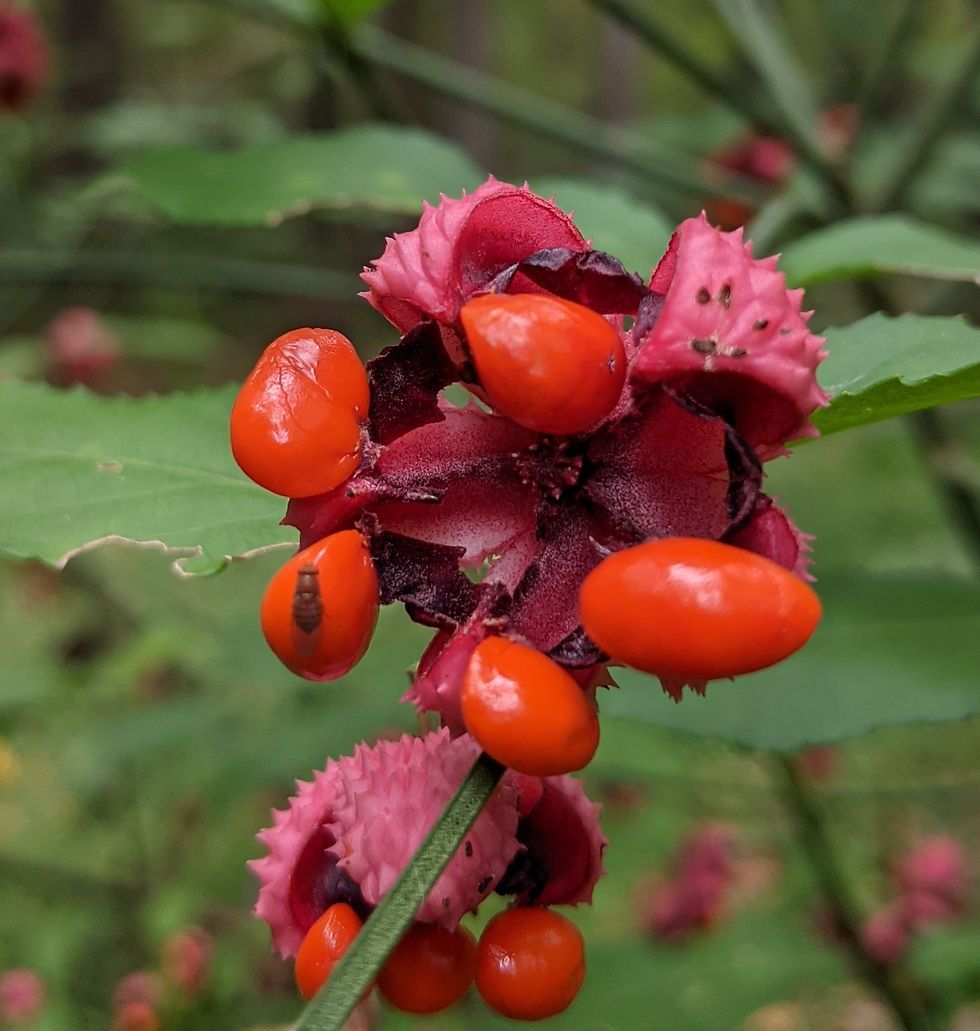Hairy Elephant Toes and Cloudless Sulfurs: The No-Footed and the Six-Footed
- Marcia Edwina Herman-Giddens

- Sep 26, 2022
- 3 min read
Around my garden and yard are the most amazing living things. Sometimes they have lessons I can learn from them, or they show me a metaphor that is useful. It is hard to pick favorites. Here are a few of the early autumn treats.
This morning a wild persimmon (Diospyros virginiana L.) called me as I was hanging out the laundry, sun streaming into an early autumnal morning. It was hearing that familiar splat when they hit the ground. This is how they tell you the orange globes are really ripe and ready to eat, otherwise they will turn your mouth inside out. At least that is what I was always told. What really happens is the bitter tannin in the unripe fruits will cause your oral mucosa to pucker until you vow you will never try another one. The word persimmon is thought to be derived from a Powhatan word meaning ‘dry fruit.’ This must have come from its unripe effect in the mouth.

Our mother tree is huge. Maybe 60 feet high. Many years ago, sadly, we had to cut down her nearby companion. The male was shading the garden too much. Even the wood is orange. We had hoped for seedless fruit. Alas. Obviously, there's a wild male somewhere because the fruit still has plenty of seeds.
The other day, I saw a cloudless sulfur butterfly, Phoebis sennae, keeping company with a monarch. The only milkweed I have is Asclepius tuberosa, the beautiful orange milkweed. I don’t know if the lone monarch found any. I worried about the delicate creature. It's always a thrill to see monarchs as it does not happen often here.
The cloudless sulfur is named after the Greek god Apollo's sister, Phoebe.

There is a lot to know about Phoebe’s long story but for now that she was known for her bright intellect suffices. Surely the sulfur’s lovely yellow signifies that. The cloudless sulfurs enchant me every autumn when they become more frequent on their southern migration. They are of the sweetest pale-yellow color that cannot help but brighten the heart. If only they would stay still to better photograph them! In my garden, the sulfurs land on bright red flowers and orange alike providing exquisite combinations. There is also another species called clouded sulfurs. If you ever seen elemental sulfur in powder form, you will know why these butterflies have sulfur in their name. Long ago, I used to sprinkle powdered sulfur in my socks to help prevent chigger and tick bites when I went out picking blackberries.

Another fall treasure, one of the no-footeds I live with (that is, plants) is hearts-a-bustin’ (Euonymus americanus. It's fairly nondescript all year until the busting happens. The seed pods burst out of their confining capsule to show off their beautiful red-orange berries. Some call this Euonymus a strawberry plant, but clearly hearts-a-bustin’ is much more descriptive. Interestingly, the fruit, seeds, and bark are full of compounds slightly poisonous to humans, but not for wildlife.
Passionflower must have the most exotic bloom there is, at least in this part of the world. It's clearly a very successful plant as there are hundreds of species. The edible one is Passiflora edula. Unfortunately, when I got seed to start my vine, I wasn't clear about all this and ended up with Passiflora caerulea which also has some poisonous properties. I had planned to make tea as several of species are known to have calming effects along with other medicinal properties. Given the species that is now in my garden, I must find my enjoyment by reveling in the exoticness of the blossoms. This year it's been blooming all summer. Early fall has slowed it a lot.

A late summer and early autumn wild no-footed in my yard (an aster!) actually has foot in its name-- hairy elephant's foot (Elephantopus tomentosus or, more likely here, Elephantopus carolinianus). I don’t remember noticing this plant until a few years ago. It has now spread over several large areas laying down its large, flat, hairy leaves that act like mulch against any competition. It is one of the few weeds I like. The name enchants me as do the tiny ray-like flowers in white or lavender. They suddenly pop up on the tip of a stalk about a foot high surrounded by three little triangular leaves (bracts) surprising me on a morning when I least expect the treat. Each little flower only lasts one day so they teach me appreciation of the precious. Its other common name is Devil’s Grandmother. I can find no explanation for such a name. I didn’t even know the Devil had a grandmother. That gives me pause.

Marcia E Herman-Giddens
September 2022
All photos except that of the cloudless sulfur (Credit: University of Florida) are by me at my place.



Ahh, Marcia, this is surely your métier! You have such an appealing way of drawing a reader in to see and appreciate the infinite beauty and complexity of the natural world through your informed and poetic point of view. This post, even though I'm late to the party, has been a highlight of this week. I especially enjoyed the reference to Phoebe--you touched my curious bone and now I want to read more.
Are you a fan of Magaret Renkl? I so appreciated her book "Late Migrations." https://www.alabamabooksmith.com/signed-copies/late-migrations-natural-history-love-and-loss
Thank you for this! Always so much love.